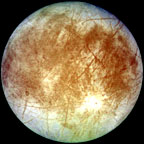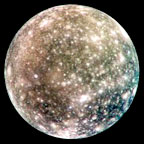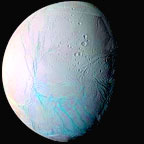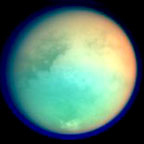Bored with Earthly beach destinations this summer? Does the word “Carribbean” not ring exactly, well, “exotic” these days? With this week’s news that (highly acidic) water has been tasted on Mars and an ethane lake has been discovered on Saturn’s moon Titan, perhaps it’s time to investigate otherworldly destinations for fun in the surf. Grab your ultraviolet-shielded swimming gear and a good beach read (say, Project Orion by George Dyson, who spoke at TED in 2003), hop aboard Virgin Galactic’s newly unveiled SpaceShipTwo, and cruise to these astonishing natural satellites orbiting Jupiter and Saturn, where summer never comes:
 Tidally bound to face its mother planet, Europa consistently offers breathtaking views of Jupiter’s turbulent atmosphere, while its breezy hardly-there chemise of molecular oxygen is delicate enough to leave the magnificent sight unobstructed. (But, beware the occasional barrage of comets yanked in by Jupiter’s gravity.) Adventurers wishing to forgo Europa’s “spa experience” will be at home, too: drill through miles of icy crust to access this satellite’s vast subsurface ocean of liquid saltwater — and whatever may lurk there.
Tidally bound to face its mother planet, Europa consistently offers breathtaking views of Jupiter’s turbulent atmosphere, while its breezy hardly-there chemise of molecular oxygen is delicate enough to leave the magnificent sight unobstructed. (But, beware the occasional barrage of comets yanked in by Jupiter’s gravity.) Adventurers wishing to forgo Europa’s “spa experience” will be at home, too: drill through miles of icy crust to access this satellite’s vast subsurface ocean of liquid saltwater — and whatever may lurk there.
 Unlike visitors to other Jovian moons, sailors to Callisto can leave their ionizing radiationscreen at home: though excessively pockmarked by impacts, its outer orbit saves it from the effects of Jupiter’s monstrous magnetosphere. Hiking enthusiasts can traverse its gigantic basin of concentric rings, Valhalla, spanning 600 kilometers, kicking through wisps of condensed oxygen. This moon’s lack of tectonic activity makes for easy access to its likely ocean of liquid saltwater. (Robert Ballard has made the case that Earth’s own oceans are still deeply mysterious.)
Unlike visitors to other Jovian moons, sailors to Callisto can leave their ionizing radiationscreen at home: though excessively pockmarked by impacts, its outer orbit saves it from the effects of Jupiter’s monstrous magnetosphere. Hiking enthusiasts can traverse its gigantic basin of concentric rings, Valhalla, spanning 600 kilometers, kicking through wisps of condensed oxygen. This moon’s lack of tectonic activity makes for easy access to its likely ocean of liquid saltwater. (Robert Ballard has made the case that Earth’s own oceans are still deeply mysterious.)
 Athletes and thrill-seekers delight at Enceladus‘ suite of extreme winter features and low gravity: spirally slalom the slopes of its unforgettable impact craters; gawk at the ivory, propane-scented violence of erupting cryovolcanoes as the panorama of Saturn‘s rings sets below the horizon; bobsled along thousand-mile escarpments of fresh chemical ice. Meanwhile, geology geeks can enjoy exploring this highly reflective moon’s incredible tectonic scars and stripes. But let divers beware: the existence of a liquid subsurface is only speculative.
Athletes and thrill-seekers delight at Enceladus‘ suite of extreme winter features and low gravity: spirally slalom the slopes of its unforgettable impact craters; gawk at the ivory, propane-scented violence of erupting cryovolcanoes as the panorama of Saturn‘s rings sets below the horizon; bobsled along thousand-mile escarpments of fresh chemical ice. Meanwhile, geology geeks can enjoy exploring this highly reflective moon’s incredible tectonic scars and stripes. But let divers beware: the existence of a liquid subsurface is only speculative.
 Titan‘s atmosphere, unique among moons, makes it a mysterious entity among other natural satellites and an attractive destination for Saturn-bound families seeking an exotic experience without patent danger (asteroid strikes are rare). Visitors willing to endure its unusual weather — the nitrogen-humid nights with the sky awash in orange; monsoons of methane and other hydrocarbons — will be rewarded by its Earth-like terrain: newly discovered lakes of ethane, vast sand dunes, a probable ocean of water-ammonia under the surface, and perhaps even microbial life. (Get your vaccinations!)
Titan‘s atmosphere, unique among moons, makes it a mysterious entity among other natural satellites and an attractive destination for Saturn-bound families seeking an exotic experience without patent danger (asteroid strikes are rare). Visitors willing to endure its unusual weather — the nitrogen-humid nights with the sky awash in orange; monsoons of methane and other hydrocarbons — will be rewarded by its Earth-like terrain: newly discovered lakes of ethane, vast sand dunes, a probable ocean of water-ammonia under the surface, and perhaps even microbial life. (Get your vaccinations!)
Our solar system is truly a cornucopia of enchanting and enigmatic phenomena. Make sure your frequent-flyer miles go to good use on your next trek by studying TEDTalks by Carolyn Porco, Bill Stone, George Dyson, Freeman Dyson and other adventurers. — Matthew Trost